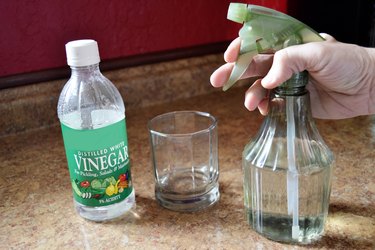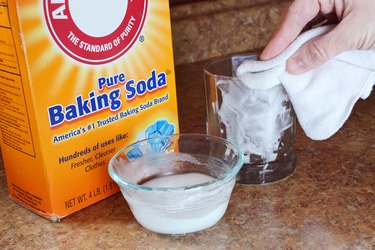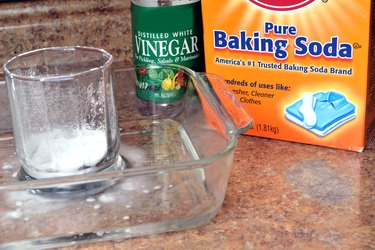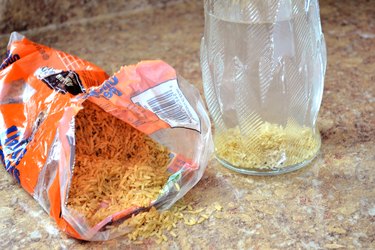
When water evaporates from glass, it sometimes leaves behind white spots or residue, which are actually minerals such as calcium or magnesium. While you could use chemicals to remove the spots, in many cases, all you need are items you already have at home, such as vinegar and water. The same homemade solutions can be used to treat calcium buildup on any glass surface such as windows, shower doors and tabletops.
Simple Spray Solution
Video of the Day

Mix equal proportions of water and white vinegar in a spray bottle. Spray the calcium deposits with the vinegar solution, then allow it to sit for 15 minutes on a flat surface before wiping it up with a lint-free, soft white cloth. For vertical surfaces such as shower stall doors or windows, spray the solution onto the spots, and then wipe the area with a lint-free, soft white cloth. If the spots don't come up right away, pour a little of the solution onto a nylon scrub pad, then scrub the spots away to dissolve mineral deposits. The same vinegar and water solution may be used as a basic glass cleaner. Squeegee or buff the glass dry afterwards to prevent new mineral deposits.
Video of the Day
Baking Soda Scrub

Make a scrubbing solution out of baking soda and water -- pour some baking soda into a shallow bowl, then stir in just enough water to give it a paste-like consistency. Dip a damp lint-free white cloth into the paste, and then rub it over the calcium spots. If the spots are difficult to remove with the cloth, pair the baking soda paste with a nylon scrub pad instead. Rinse the baking soda away with water; wipe the glass dry with a lint-free cloth.
Super Soak for Stubborn Buildup

Spray or pour a little pure white vinegar over stubborn spots, allowing the vinegar to sit for 30 minutes. Sprinkle baking soda over the affected area afterwards, using the baking soda as an abrasive to scrub the remaining residue away with a nylon scrub pad. Do not pour baking soda into the vinegar right away because the two immediately react with one another by fizzing, canceling out the beneficial properties of each substance. Waiting a while allows the vinegar to dissolve much of the calcium first. For hard-to-remove stains, you may need a commercial cleaner, but pay attention to the product's use warnings on the label or package.
Glass Container Cleaner

Calcium deposits also occur inside glass vessels such as jars, bottles and vases after water evaporates. Clean the inside of the glass item by first washing it in warm, soapy water, swirling some of the water around. If the white spots remain, fill the glass with enough vinegar or lemon juice to cover the spots. Both vinegar and lemon juice act as acids that remove such buildup. Place a handful of uncooked rice in the glass, then swirl it around so the hard rice rubs against the glass. Allow the glass to sit overnight or all day, swirling it around once in a while. Strain the rice from the vinegar before dumping the vinegar down the drain.